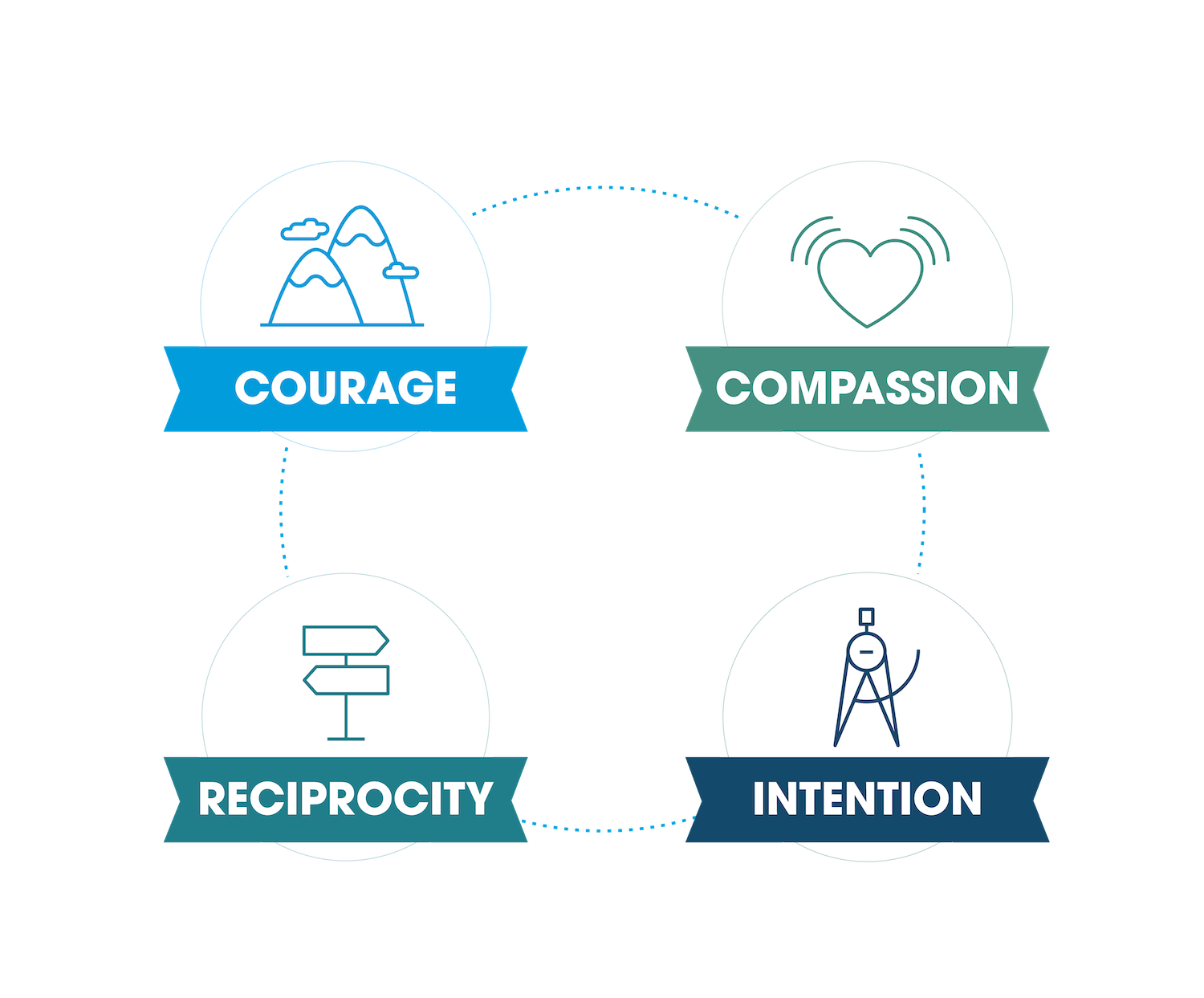These 4 Mindsets Can Improve Your Business Relationships



Salesforce’s Design team has developed a philosophy that centers relationships as the building blocks of business and social value. Here’s why we think it works.
As businesses have shifted to a hybrid world, they’ve had to respond to many new challenges. Figuring out how to hire and onboard employees virtually, implementing new modes of customer service, and understanding how to operate more sustainably are just a few of the complexities on the table. What’s at the heart of these scenarios? You’d be right if relationships came to mind.
Salesforce Design has been developing a philosophy and method that centers relationships as the building blocks of business and social value. We call it Relationship Design and it’s based on four mindsets that anyone in any industry or role can adopt: compassion, intention, courage, and reciprocity.
Incorporating these mindsets can help you bring more humanity to technology and business. We also have a Relationship Design toolkit that can get you started on some key practices.

Practicing Relationship Design mindsets
When a relationship is new – be it with a person, product, or environment – you may wonder whether it’s “safe.” When employees feel psychologically safe, they are more creative, more productive, and more likely to extend empathy to their customers.
Companies that design products and services from a place of compassion build customer trust, outperform their peers, and gain market advantage. Both employees and customers are loyal to companies that help them feel safe and supported.
“A company’s job is to connect with customers and, in order to do that, you need to understand where they’re at,” said Lauren Peters Lague, senior director, Salesforce Design. “You simply can’t do that without compassion. You have to have empathy for where they are in their lives and how your product or service can provide value to them.”
How you can practice compassion:
1. Reward employees for taking thoughtful risks, even if it ends in failure.
When employees feel free to experiment and solve problems in creative ways, it leads to better solutions. Encourage them to share unfinished work, and give and receive constructive criticism.
2. Truly understand other perspectives and motivations.
When tensions arise, pause for a moment. Talk to the other person to understand their perspective and motivation. Understand their lived experience, and create products and services that meet their needs.
3. Build teams that learn from differences.
Make people feel included and to actively listen to them. Provide safe spaces for historically underrepresented people to share their perspectives. Everyone has biases, but teams of people who can check one another’s weak spots can build solutions that reach more customers.
Build trusted relationships
When you put people first, you shift from a transactional to a trusted relationship. Being intentional is about taking the time to reflect. That makes it easier for you to assess the ripple effects of any decisions you make and to avoid unintentional harm to others and your company’s reputation. There are Relationship Design tools you can use to guide this thinking.
“Intention for us means a real focus and a plan for how we do our work,” said Melissa Lemberg, vice president, Salesforce Global Experience Design. “That means an approach that’s user-led, that’s design-led, that focuses on key user needs and objectives, challenges in getting the work done.”
How you can practice intention:
1. Set and commit to relationship-centered goals.
Hold teams accountable for relationship building. Prioritize metrics that collect customer experience data, such as Net Promoter Score and Customer Satisfaction Score, over vanity metrics, such as reach or downloads.
2. Research the impact of your actions on nonusers and noncustomers.
Consider all the possible good and negative effects of your decisions. Use tools to imagine potential consequences, such as scenario planning and consequence scanning.
3. Hold your work accountable to your organization’s mission and values.
Think about potential risks and how you might prevent future issues. For example, Salesforce began running equal-pay assessments in 2015 to evaluate wage gaps and make adjustments, a practice that continues today.
Doing what’s right
Salesforce CEO Marc Benioff always says that business is the greatest platform for change. Organizations need to hold themselves responsible for inspiring and leading systemic change. It takes courage to be transparent and to do what’s right, instead of what’s expected. Growth happens when people admit their fallibility and move forward together.
“It can take courage to look an executive in the face and tell them that a reality that they believe to be true is, in fact, not as firm as they would have you believe,” said Marc Escobosa, vice president, Salesforce Digital Strategy and Design.
How you can practice courage:
1. Live your values, even when it’s at odds with desired business outcomes.
A culture of courage comes from pushing against perceived boundaries. Share your values with your customers and stick to them.
2. Empower your employees to challenge the status quo.
Create a forum where employees can air grievances. Reward employees for raising red flags when a business decision doesn’t uphold your mission. Encourage them to speak up for accessibility in product design, representation in marketing, inclusion in recruiting, hiring, and promoting.
3. Be open and vulnerable, even when you want to be safe.
Be transparent about pay equity at your company, your environmental impact, and the demographics of your workforce. Own up when your actions fall short of your values, and take steps to repair any damage.
A little more conversation
A relationship is a two-way street. You have to listen to your customers because they know their challenges and needs best. Instead of designing for them, you need to design with them.
When you collaborate with the people and communities who need your products and services, you create better solutions. The insights they share can inspire products that actually make their lives better, which in turn makes your business stronger. To stay relevant, you have to keep the conversation going to learn how people’s needs change. People stick with brands that stick with them.
“When we make a solution, an interface, a product, and put it out into the world, it becomes an intermediary for how people interact with one another,” said Kat Holmes, senior vice president, Salesforce Product Design and UX. “And the design consideration that goes into the kind of value they’re trying to gain or give in that moment is incredibly important to emphasize, to understand.”
How you can practice reciprocity:
1. Engage in shared learning beyond the walls of your company.
Seek opportunities to partner with people and organizations outside of your company. Embrace coalition models and collaborative problem-solving. Value the wisdom of your customers and community, and find ways to engage them in your process.
2. Lean into mutual exchange and accountability.
Encourage customer engagement with opportunities for direct feedback and involvement in creating solutions. At Salesforce, 10% of our product updates come from our IdeaExchange forum. When people feel a sense of ownership in an idea, they invest in its success.
3. Listen openly and share candidly.
Use tools to understand the landscape around your business: What are your customers saying about you and your products? What about your competitors? Gather and interpret customer feedback to keep adding value to their lives. And follow up with them to demonstrate you value their participation.
Designing a better normal
Reimagining the systems that connect businesses and customers requires focusing on the relationships behind them. Using Relationship Design tools and incorporating compassion, intention, courage, and reciprocity into your business practices is a good start. Nothing happens overnight, but every wave starts with a ripple.
Explore Relationship Design tools
Get to know Relationship Design and how the toolkit can help you map, workshop, and design your way to a human- and heart-centered future.




























